VB/C#
Need Help in Visual Basic and C# Assignments?
We can help you if you are having difficulty with your Visual Basic Assignment. Just email your assignments at support@assignmentcache.com.
We provide help for students all over the world.
-
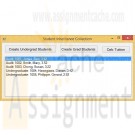
Advanced Visual Basic 2010 Chapter 6 Programming Challenge 6 Undergraduate and Graduate Students
Regular Price: $25.00
Special Price $20.00
Advanced Visual Basic 2010 Chapter 6 Programming Challenge 6 Undergraduate and Graduate Students
Tutorial 6-8 presented classes named Student and GradStudent. In this programming challenge, you will build on that application. Create another class named AuditStudent that inherits from Student. Create a suitable constructor. Add a CreditsEnrolled property to the Student class, of type Double. Add a TuitionAmount property, of type Decimal.
Learn More
Audit students and undergraduate students pay the same tuition rate per credit hour. Graduate students pay a different rate. The two tuition rates should be initialized by assigning values to shared properties in the two classes. The TuitionAmount property calculates the amount due by multiplying the CreditsEnrolled by TuitionAmount. However,in the AuditStudent class, add an additional $100 to the TuitionAmount value. For graduate students, the total tuition amount is the same for nine credits as it is for any number of credits higher than that.
Create a user input form that lets the user select a student by name from a list, input the number of credits enrolled, and view the student’s tuition amount. -
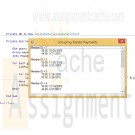
Advanced Visual Basic 2010 Chapter 7 Programming Challenge 3 Grouping Karate Payments
Regular Price: $12.00
Special Price $10.00
Advanced Visual Basic 2010 Chapter 7 Programming Challenge 3 Grouping Karate Payments
Use the Group By operator to group the Payments table by member ID. Display the member ID in the outside group, and display the individual payment dates and amounts within each group. Write the output to a ListBox control, as demonstrated in Figure 7-19.
Learn More -
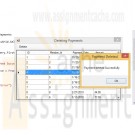
Advanced Visual Basic 2010 Chapter 7 Programming Challenge 2 Deleting Payments
Regular Price: $12.00
Special Price $10.00
Advanced Visual Basic 2010 Chapter 7 Programming Challenge 2 Deleting Payments
Create an application that lets the user delete payments from the Karate database. Use an Object data source and a BindingSource control. Add a ToolStrip control containing a Delete button, as shown in Figure 7-18. Display all payments in a DataGridView control. When the user selects a payment and clicks the Delete button, LINQ queries that delete the payment and refresh the grid are executed.
Learn More -
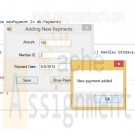
Advanced Visual Basic 2010 Chapter 7 Programming Challenge 1 Adding New Payments
Regular Price: $15.00
Special Price $12.00
Advanced Visual Basic 2010 Chapter 7 Programming Challenge 1 Adding New Payments
Create an application that lets the user add new payments to the Karate database. Use an Object data source, a LINQ query, and a BindingSource control. Do not use a MenuStrip control, but use a Save button to save the payments. Add a Show Payments button that displays the Payments table on a separate form in a DataGridView control. A sample main form is shown in Figure 7-17. Catch all exceptions and display a message box if an exception is thrown. Display a confirmation message when a row is added successfully. Hint: Be sure to initialize the BindingSource’s DataSource property with a LINQ Select query when the form is loaded.
Learn More -
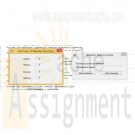
Advanced Visual Basic 2010 Chapter 6 Programming Challenge 9 Weather Station Summary
Regular Price: $20.00
Special Price $15.00
Advanced Visual Basic 2010 Chapter 6 Programming Challenge 9 Weather Station Summary
The purpose of this programming challenge is to show how events raised by a class can be broadcast to more than one class. Use the Weather Station Events application from Tutorial 6-7 as a starting point for this programming challenge. Create a Summary form, as shown in Figure 6-29, that keeps a running count of each type of event raised by the WeatherStation class. The Summary form’s class contains an event handler for each type of event raised by the WeatherStation class. Just before showing the Summary form, the main form can pass to it a reference to the same WeatherStation object declared at the top of the main form. Use the Show (not ShowDialog) method to display the Summary form. As events appear on the main form, the summary form counts the number of each type of event that has been raised so far.
Learn More -
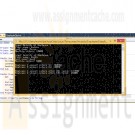
Visual Basic 2010 How to Program Deitel Exercise 9.7 Employee Class
Regular Price: $12.00
Special Price $10.00
Visual Basic 2010 How to Program Deitel Exercise 9.7 Employee Class
(Employee Class) Create a class called Employee that includes three pieces of information as instance variables-a first name (type String), a last name (type String) and a monthly salary (type Integer). Your class should have a constructor that initializes the three instance variables. Provide a property for each instance variable. The property for the monthly salary should ensure that its value remains positive-if an attempt is made to assign a negative value, throw an exception. Write an application that demonstrates class Employee's capabilities. Create two Employee objects and display each object's yearly salary. Then give each Employee a 10% raise and display each Employee's yearly salary again.
Learn More -
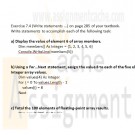
Visual Basic 2010 How to Program Deitel Exercise 7.4 Write statements
Regular Price: $12.00
Special Price $10.00
Visual Basic 2010 How to Program Deitel Exercise 7.4 Write statements
Write statements to accomplish each of the following task:
a) Display the value of element 6 of array members.b) Using a For...Next statement, assign the value 8 to each of the five elements of one-dimensional Integer array values.
c) Total the 100 elements of floating-point array results.
d) Copy 11-element array source into the first portion of 34-element array sourceCopy.
e) Determine the smallest and largest values in 99-element floating-point array data.
Learn More -
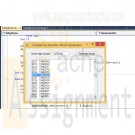
Visual Basic 2010 How to Program Deitel Exercise 7.15 Telephone-Number Word Generator
Regular Price: $20.00
Special Price $15.00
Visual Basic 2010 How to Program Deitel Exercise 7.15 Telephone-Number Word Generator
(Telephone-Number Word Generator) Standard telephone keypads contain the digits zero through nine. The numbers two through nine each have three letters associated with them(Fig 7.29). Many people find it difficult to memorize phone numbers, so they use the correspondence between digits and letters to develop seven-letter words that correspond to their phone numbers. For example, a person whose telephone number is 686-2377 might use the correspondence indicated in Fig. 7.29 to develop the seven-letter word "NUMBERS." Every seven-letter word corresponds to exactly one seven-digit telephone number. A restaurant wishing to increase its takeout business could surely do so with the numbers 825-3688 (that is, "TAKEOUT"). Every seven-letter phone number corresponds to many different seven-letter combinations. Unfortunately, most of these represent unrecognizable juxtapositions of letter. It's possible, however, that the owner of a barbershop would be pleased to know that the shop's telephone number, 424-7288, corresponds to "HAIRCUT." A veterinarian with the phone number 738-2273 would be pleased to know that the number corresponds to the letters "PETCARE." An automotive dealership would be pleased to know that the dealership number, 639-2277, corresponds to "NEW CARS."
Write an application that allows the user to enter a seven-digit number in a TextBox, and displays every possible seven-letter word combination corresponding to that number in a multiple line scrollable TextBox when the user clicks the Generate Words button. There are 2,187 (3 To the seventh power) such combinations. Avoid phone numbers with the digits 0 and 1.
Learn More -
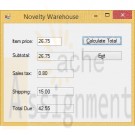
Programming in Visual Basic 2010 Chapter 4 Novelty Solution
Regular Price: $15.00
Special Price $12.00
Programming in Visual Basic 2010 Chapter 4 Novelty Solution
Create a Visual Basic Windows application. Use the following names for the solution, project, and form file, respectively: Novelty Solution, Novelty Project, and Main Form.vb. Save the application in the VB2010\Chap04 folder. Create the interface shown in the figure 4-65. When the user clicks the Calculate Total button, the button's Click event procedure should add the item price to the total of the prices already entered; this amount represents the subtotal owed by the customer. The procedure should display the subtotal on the form. It also should display a 3% sales tax, the shipping charge, and the grand total owed by the customer. The grand total is calculated by adding together the subtotal, the 3% sales tax, and a $15 shipping charge. For example, if the user enters 26.75 as the item price and then clicks the Calculate Total button, the button's Click event procedure should display 26.75 as the subtotal, 0.80 as the sales tax, 15.00 as the shipping charge, and 42.55 as the grand total. If the user subsequently enters 30 as the price and then clicks the Calculate Total button, the button's Click event procedure should display 56.75 as the subtotal, 1.70 as the sales tax, 15.00 as the shipping charge, and 73.45 as the grand total. However, when the subtotal is at least $100, the shipping charge is 0.00. Code the application. Save the solution and then start and test the application. Close the code editor window and then close the solution.
Learn More -
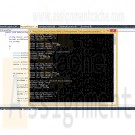
CSIS 209 Programming Assignment 7 Account hierarchy
Regular Price: $15.00
Special Price $12.00
CSIS 209 Programming Assignment 7 Account hierarchy
Adapted from: Deitel & Deitel (2017). Visual C# 2015 How to Program (6th ed.). Pearson Education, Inc.
Based on the program you created for Assignment 5, modify your code to perform the following steps.
In Assignment 5, you created an Account hierarchy with a base class (Account) and two derived classes (SavingsAccount and CheckingAccount). Three of the mutator methods in this assignment validated user input: setBalance, setInterestRate, and setFeeCharged. In all of these methods, you were instructed to set the respective variables equal to zero if the user passed in a negative amount. In this assignment, you will modify your code such that if the user passes in a negative amount, an exception will be thrown that alerts the user that a negative amount has been entered. The program should catch the exception and display the error message to the user. Once an error (negative amount) has occurred, the program should inform the user that negative numbers are not permitted. It should then redisplay the menu. If an exception has not occurred, and a checking or savings object has been successfully created, the program should print the information for that object.
[Hint: You will need to create an exception class – call it NegativeNumberException – that takes a string as an argument to its constructor that represents the error. The string should be "Invalid Entry – Negative numbers are not permitted."]
Modify your Main() method such that instead of hardcoding the SavingsAccount and CheckingAccount information, you prompt the user to enter the needed information. Generate a menu like the one below and loop until the user enters "Q" to quit the application.
Based on the 18 steps required for Assignment 5, you only need to implement steps 1 and 2 and instantiate their creation based on the user's menu selections. You may remove steps 3 through 18. This assignment is only intended to demonstrate your ability to handle exceptions.
Learn More





